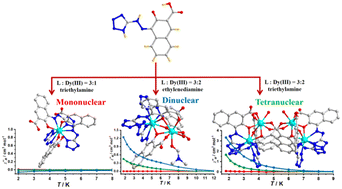A new compound of azotetrazole-3-hydroxy-2-naphthoic acid (H3ATNA) has been successfully synthesized and characterized. By controlling the ratio of metal ions to the ligand and the pH value of solution, mononuclear, dinuclear and tetranuclear dysprosium(III) complexes [Et3NH]3[Dy(HATNA)3]·5H2O (1), [Dy2(HATNA)3(DMF)(H2O)]·2DMF·CH3OH·2H2O (2) and [Et3NH]6[Dy4(ATNA)6(H2O)2]·DMF·2CH3CN·8H2O (3) were synthesized and characterized by X-ray diffraction crystallography (DMF = N,N-dimethylformamide). Crystallographic data demonstrate that the neutral H3ATNA exists as a hydrazone tautomer. Complex 1 is a mononuclear structure, in which the Dy(III) ion is a nine-coordinated ion surrounded by three tridentate HATNA− ligands. Complex 2 shows a dinuclear structure, which is bridged by three μ1,1-hydroxyl groups of three HATNA− ligands. In complex 2, the Dy(III)1 ion is a nine-coordinated ion surrounded by three tridentate HATNA− ligands, while Dy(III)2 is an eight coordinated atom with three tridentate HATNA− ligands, one DMF and one water molecule. Complex 3 displays a tetranuclear structure, which can be approximately considered as two μ1,3-carboxyl groups of ATNA3− ligands linking complex 2. The magnetic properties of 1–3 were investigated. Complexes 2 and 3 display slow magnetic relaxation in a zero dc field.

